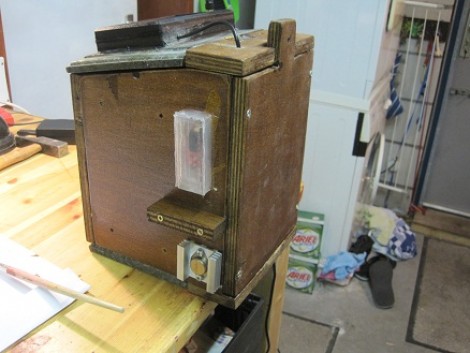
[Stephen Albers] offers his avian friends a lot of extras with this electronically monitored bird house. This will not only give you a look at what’s going on inside, but provide a source for several other bits of data as well.
First off, a camera has been mounted to the underside of the roof. This looks down on the nesting area and features night vision so that you can peek in any time day or night. He used a WiFi webcam that operates separately from the other electronics.
With the remainder of the setup he is able to harvest temperature and humidity data inside, temperature outside, force on the bottom of the house (although this turned out to be less useful than anticipated), and a in-and-out count for the doorway provided by an IR transmitter/receiver pair.
This offers quite a bit more than the last bird house project we saw. That one also left a lot to be desired as far as protecting the electronics. [Stephen] didn’t skip on that kind of protection. Most of the electronics are housed in an acrylic chamber in the base of the house. The sensors find themselves nestled in plastic enclosures, although some work needs to be done to ensure that the temperature and humidity sensors will still function correctly with this setup.















Cool setup, though not sure any birds will be brave enough to stay inside…
Cool, if not a bit overkill. I do have a couple of observations (constructive criticism, not whining). For one, the humidity sensor is in a sealed box – and will probably never change. Maybe add a hole or two for some airflow.
Also the IR camera – won’t this interfere with the IR in/out sensor? And can birds see IR? Might drive them away…
neat project. seems like that 7805 regulator on the back is quite the eyesore. a small switching regulator would be better. nicely done though!
@ Alex
They can’t. (I can’t believe i even looked it up, i have too much time on my hands, maybe i should build a birdhouse…)
http://www.birds.cornell.edu/nestinginfo/nestboxcam/06_archives/barn_owl_ca/ca_ba_comments/talkback/1142621973/discussionitem_view
@Alex, I don’t think they can see IR, but they see a lot of ultraviolet. http://en.wikipedia.org/wiki/Bird_vision
And instead of drilling holes in the temp enclosure, you could find the temp difference that is made by it and then calculate the difference into your readings. This could help a lot, and make your sensor last longer.
@J, zacdee16:
Thanks for the info on IR, lol.
As far as hole drilling goes though, with the humidity sensor in a sealed box the humidity will never change no matter what the humidity is outside it, unlike the temperature.
Put the heatsink inside, birds will love to get little warm.